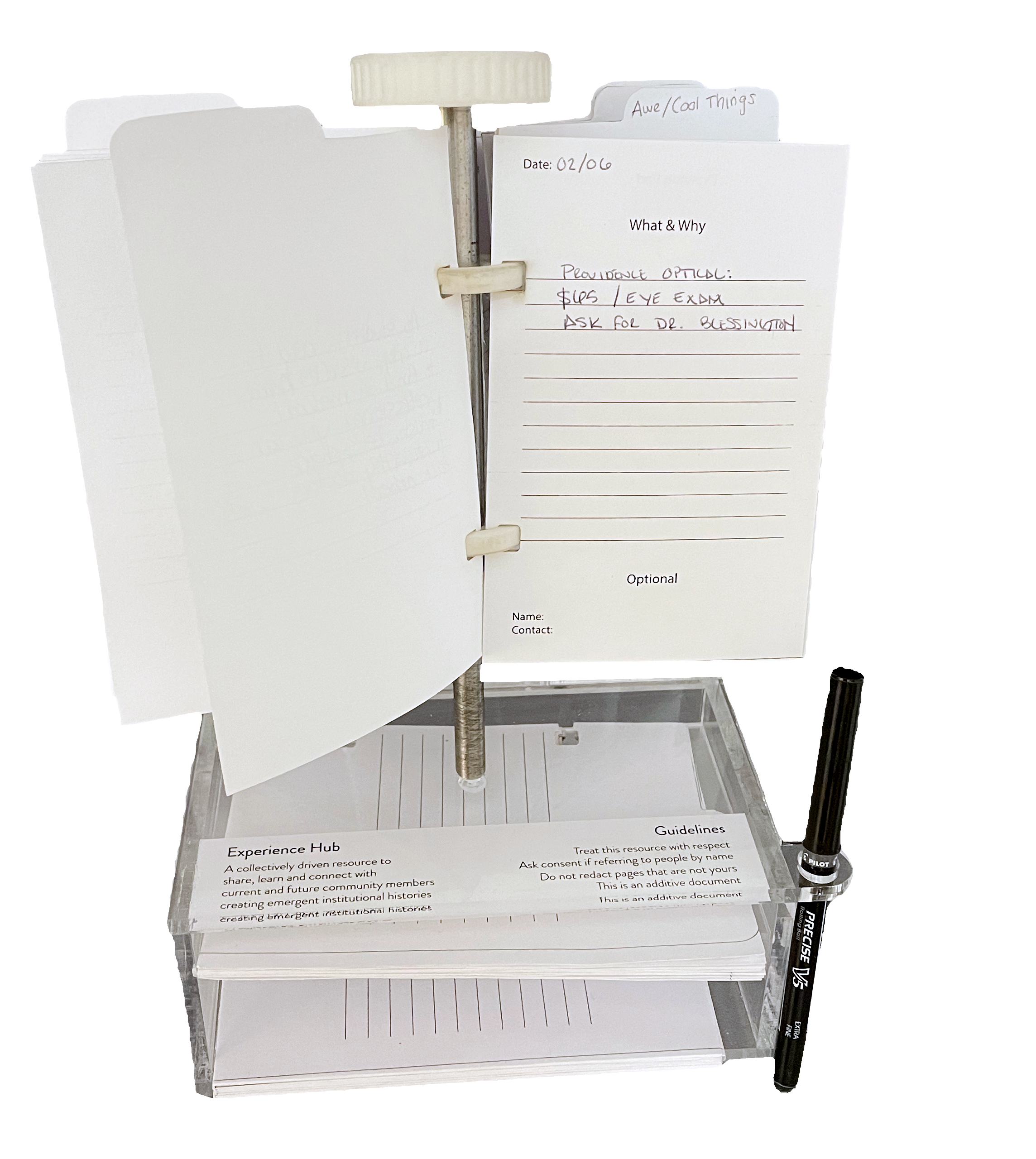
We Got This
Masters Thesis (Sep. 2021 - May 2022)
My two semester graduate thesis work investigates building resilient cultures of collective care in pressurized workplaces. Its focus is on the Rhode Island School of Design MID (Master of Industrial Design) program as a proxy. While every work environment has its own specific context, many work cultures face similar challenges. The aims, avenues, tools, and social events in this thesis have applicability beyond the context of RISD.
The semesters were broken down into Thesis Research in the fall and Thesis Making in the spring. I had weekly meetings with two internal advisors and one external advisor. The deliverables for this project included a thesis exhibition and thesis book, which documented my process.
Process
The foundational research for this project consisted of secondary score material on organizational well being and 24 community interviews focusing on identifying areas of connection and disconnection.
From there I developed my hypothesis: Providing social and emotional support and creating space for collaboration leads to stronger work with less stress. We can increase collaboration and promote engaged pedagogy through social events and improving information opacity.
I then tested and supported this hypothesis through experimental and generative research. This included developing artifacts aimed at increasing information opacity and co-creating two recurring social events.
Challenge
In the RISD Industrial Design Department unproductive stressors for teachers and students in an individualistic culture of overwork were leading to siloing (lack of human connection), diminished project outputs, and burnout. I conducted surveys, opinion polls and expert interviews to support this claim. One of the primary clinical psychologists at RISD I interviewed reported that she was seriously questioning RISD’s culture of overwork.
The global Covid-19 pandemic further exacerbated the situation. Since the pandemic loneliness, mental health issues, and burnout have increased. Over 24 million Americans left their jobs between April and September of 2021. Record setting numbers. Employers are turning their attention towards employee engagement and are thinking hard about what the future of work looks like.
The global Covid-19 pandemic further exacerbated the situation. Since the pandemic loneliness, mental health issues, and burnout have increased. Over 24 million Americans left their jobs between April and September of 2021. Record setting numbers. Employers are turning their attention towards employee engagement and are thinking hard about what the future of work looks like.
Results
I createdinterventions that continue to promote lasting change in a predominantly transitory system. I designed and built The Share Board, a low stakes community resourcing artifact that is still heavily used by the Industrial Design department today. ⅓ of the 60 input slots were filled within the boards first two weeks. This validated interest in connection and the importance of artifacts.
The response to the Community Values worksop I co-designed with classmate Jenny Chen was overwhelmingly positive. 70% of the department were in attendance. As a group we worked to define our values and ideate ways we might better support them. Thanks to administrative support, this workshop is now held annually. We created a website for the events that includes digital archives, workshop instructions, and accompanying Slide Decks to aid in its facilitation.
The response to the Community Values worksop I co-designed with classmate Jenny Chen was overwhelmingly positive. 70% of the department were in attendance. As a group we worked to define our values and ideate ways we might better support them. Thanks to administrative support, this workshop is now held annually. We created a website for the events that includes digital archives, workshop instructions, and accompanying Slide Decks to aid in its facilitation.
Foundational Research

Secondary Source Material
The source material primarily focused on organizational design, education, and social wellbeing; adrienne maree brown’s Emergent Strategy and bell hook’s Teaching to Transgress being seminal texts.
Takeaways
- Organizational wellbeing is at the root of creating an engaged and empowered workforce
- Designed and structured interactions can promote collaboration
- Dialogue and discursive spaces promote agency, cross boundaries and reduce anxiety
- Artifacts are valuable reflection of culture

Interviews
I ran 24 interviews (13 students and 11 professors). The interviews were informal 30 minute conversations focused on identifying areas of connection and disconnection within the program. By deepening relationships within the RISD community I was able to better understand the attitudes and specific contexts of its members.
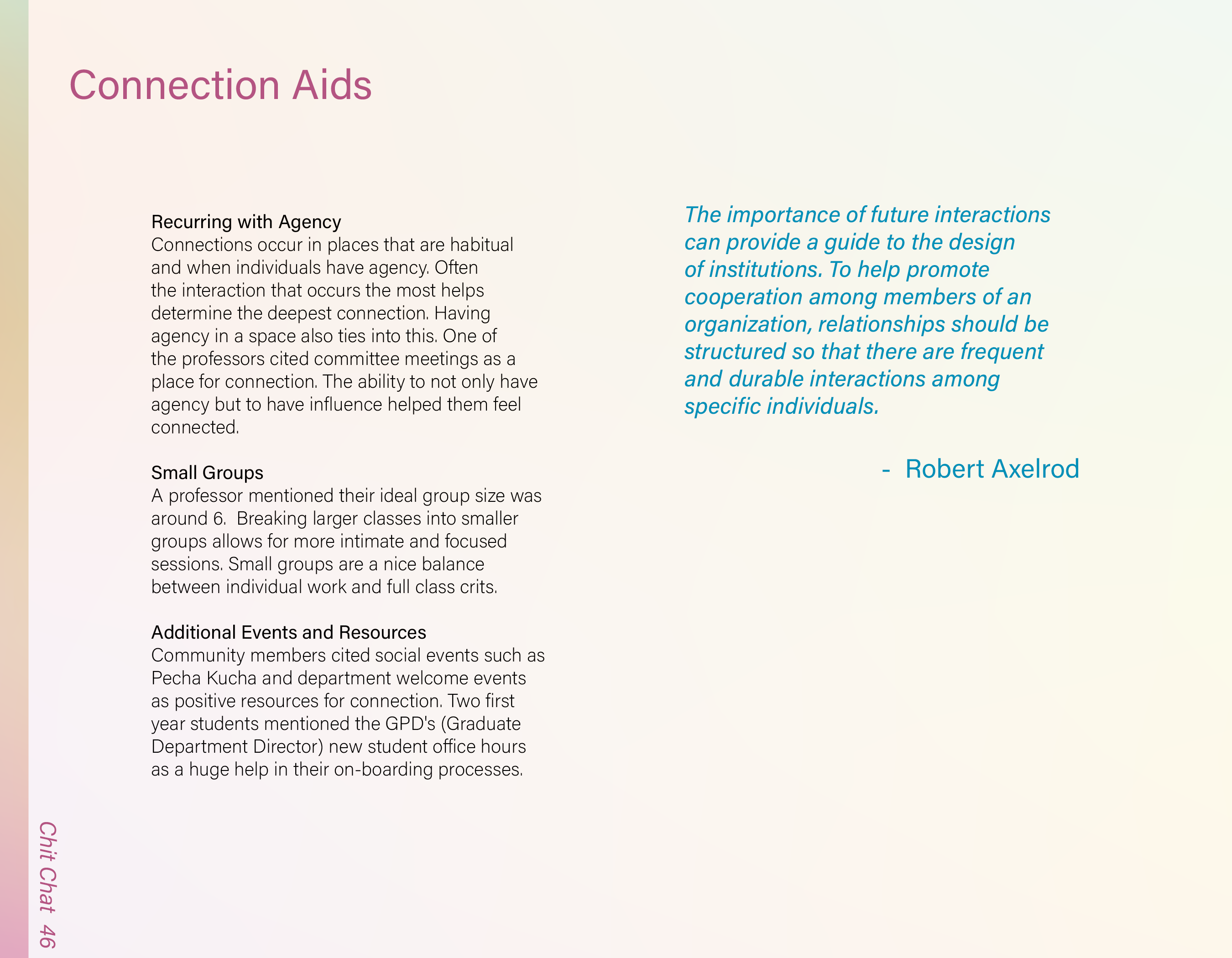
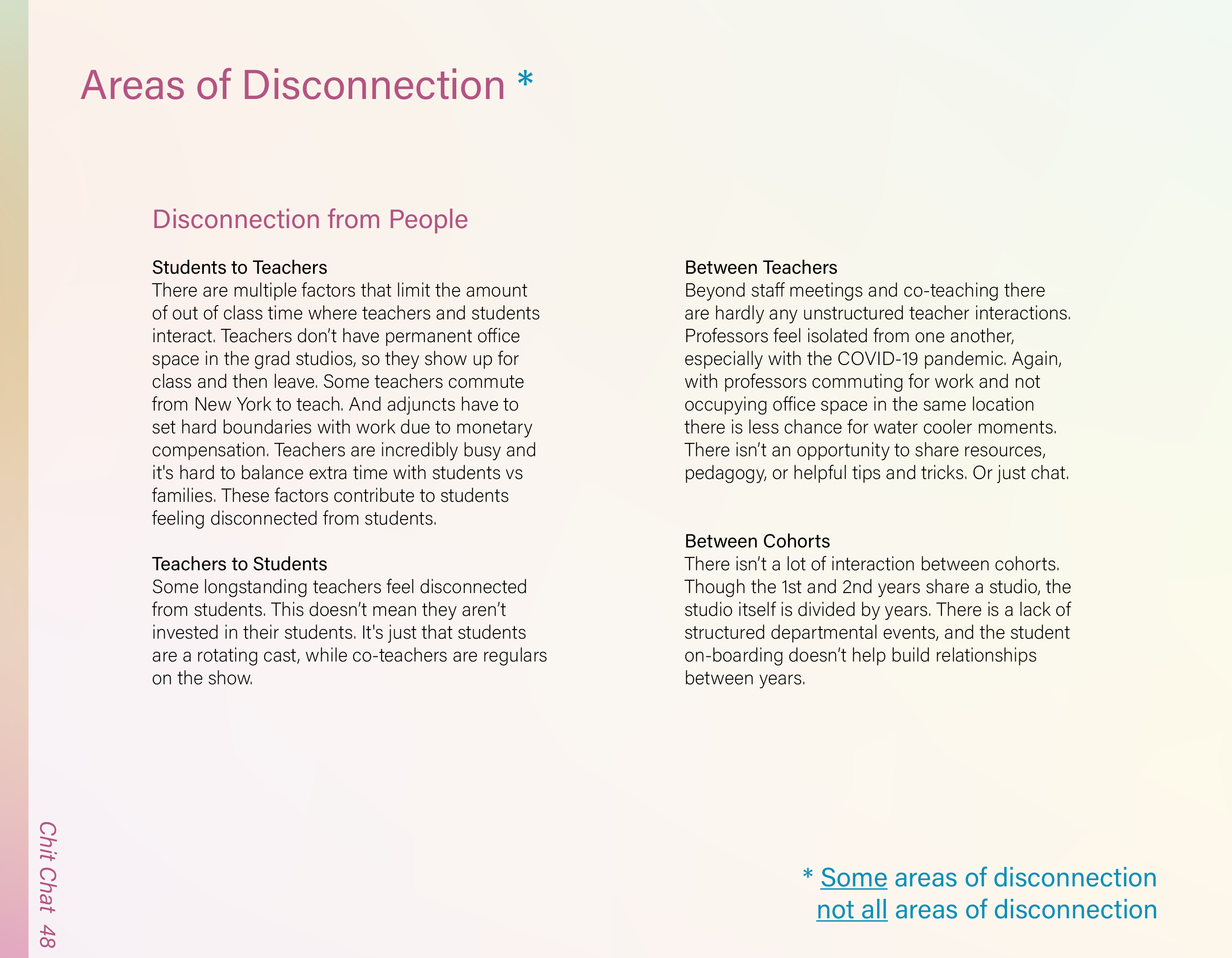

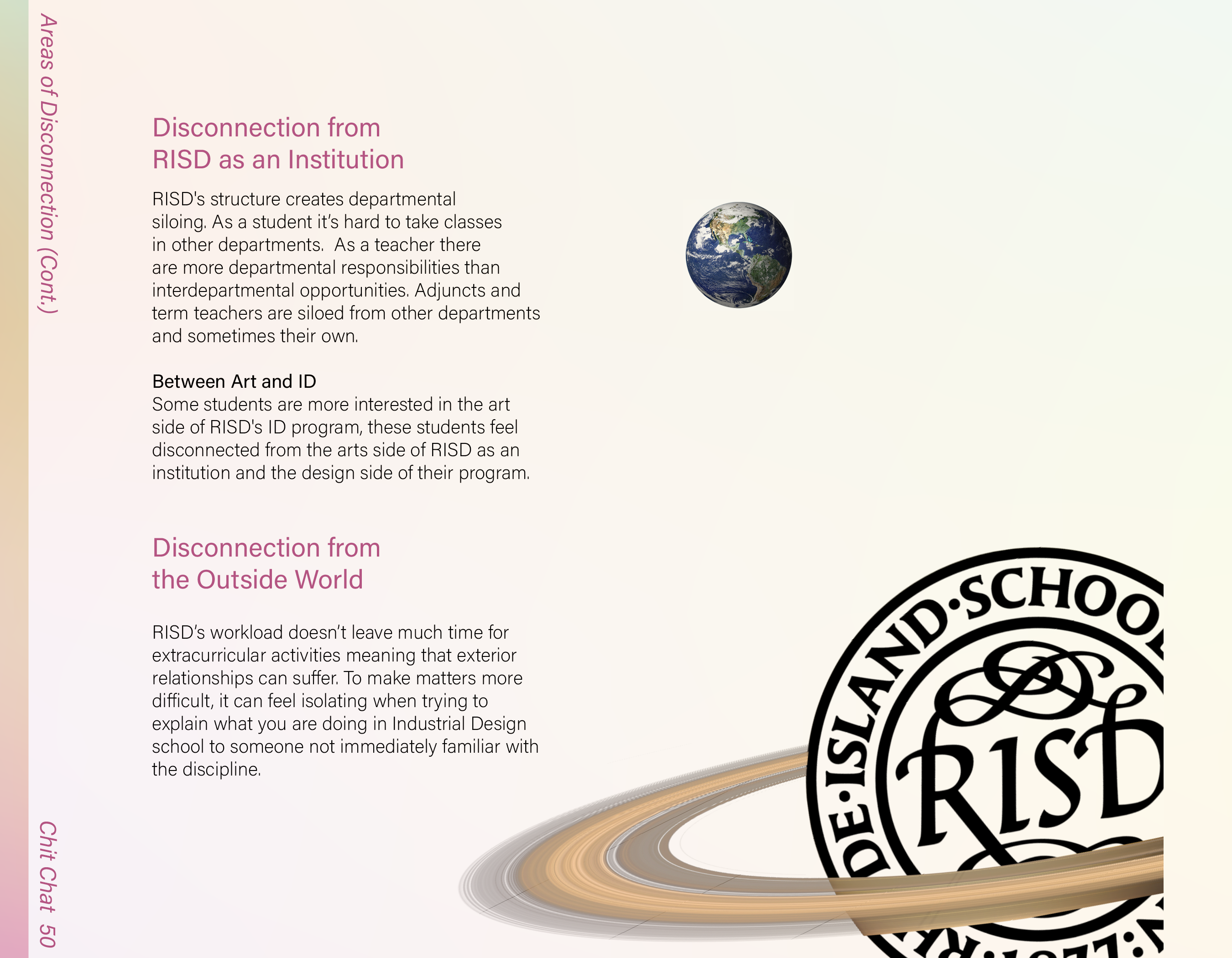
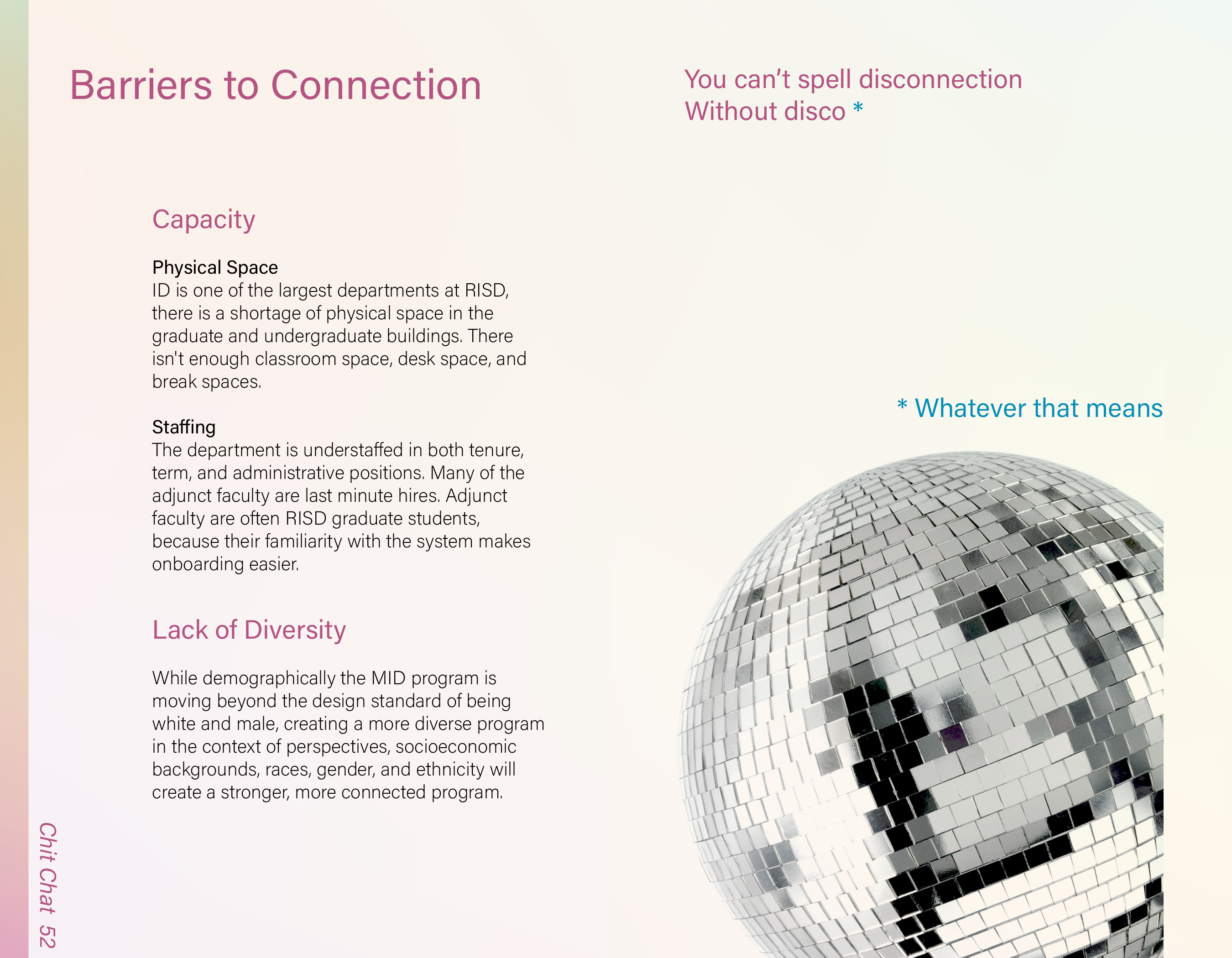


Hypothesis:
Providing social and emotional support and creating space for collaboration leads to stronger work with less stress. We can increase collaboration and promote engaged pedagogy through creating social events and improving information opacity.
Hypothesis Aims
Increase Collaboration - We learn through helping and being helped. By taking pressure off individual outcomes we can shift the paradigm from relationships of support to ones of collaboration. This creates more opportunities for community members to share their skills and resources with one another.
Hypothesis Avenues
Creating Social Events - Help to increase the quantity and quality of connections between community members. More programming means more interactions with the community. The combination of structured and unstructured events will build relationships, foster collaboration, and create dialogue leading towards a more engaged pedagogy.
Promote Engaged Pedagogy - Means creating an atmosphere of intellectual and spiritual growth for both teachers and students by prioritizing social and emotional support in addition to academic achievement. This practice incorporates vulnerability into education, which leads to increased connection, trust, and engagement. Dialogue creates opportunities for teachers and students to share life experiences and emotions, including discomforts. Conversations around our challenges, fears, and struggles within academia help normalize stressors as part of the academic process.
Improving Information Opacity - The goal here is incremental shifts towards clarifying, streamlininging, and creating consistency in how expectations, information, and feedback are accessed, given, and shared. Understanding expectations reduces discomfort and enables us to
prepare for success.
Designing Artifacts
Design & Structure
The artifacts I designed to test my hypothesis are participation driven platforms which provide a structure that guides engagement rather than determines outcomes. They are primarily geared towards increasing interpersonal information opacity and community resourcing, by providing opportunities for community members to share information and learn about one another. These artifacts hold, display, and archive community input.
Taking into consideration the changing needs of a community with high turnover, these artifacts are designed to be easily reset, readjusted, and reused simply by removing cards.
Experience Hubs



